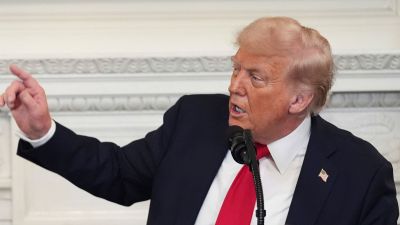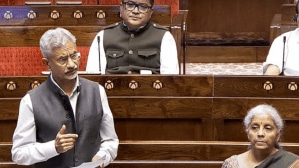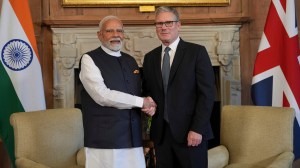At Delhi’s India International Centre, walk through the world of satire of cartoonist Abu Abraham
Marking his birth centenary year, the showcase at India International Centre in Delhi, on till November 19, brings together over 200 works of Abraham, recognised as one of India's finest political cartoonists.
 E P Unny, Chief Political Cartoonist at The Indian Express, led a walkthrough of the exhibition on November 7 at the India International Centre in New Delhi. (Express/Abhinav Saha)
E P Unny, Chief Political Cartoonist at The Indian Express, led a walkthrough of the exhibition on November 7 at the India International Centre in New Delhi. (Express/Abhinav Saha)Born on June 11, 1924, cartoonist Attupurathu Mathew Abraham’s formative years in Quilon (Kollam) were nurtured in a nation in transition. A witness to the struggles of colonial India, he was to later document its growth as an independent nation battling challenges and standing on its own.
At three, he was already attempting to sketch the world as he saw it through his eyes, and by 12, he was studying portraits of luminaries on postcards. “He was an untrained artist and obviously gifted,” states his daughter Ayisha Abraham, who, along with her sister Janaki Abraham, has curated the exhibition “Abu’s World”.
Marking his birth centenary year, the showcase at India International Centre in Delhi, on till November 19, brings together over 200 works of Abraham, recognised as one of India’s finest political cartoonists.
“With minimal lines, he said a lot. He was one of the trio — O V Vijayan, Rajinder Puri and Abu — who shaped the Indian editorial cartoon,” noted E P Unny, Chief Political Cartoonist at The Indian Express, who led a walkthrough of the exhibition on November 7.
Recalling how he grew up admiring his work, Unny added, “Abu was one of the finest chroniclers of the Indira era… Working with The Indian Express, he was fortunate to have a nationwide reach and commented on a wide range of subjects.”
Spanning his long career, the display documents some of the key periods that Abraham represented as well as his stylistic transitions.
Though the cartoonist, who passed away in 2002, cherished a passion for art since early on, the graduate from University College in Thiruvananthapuram began his career as a newspaper reporter in Mumbai who published his drawings in several journals. In 1951, he joined Shankar’s Weekly, a satirical magazine founded by Keshav Shankar Pillai.
In 1953, he set sail for England at the behest of British cartoonist Fred Joss, who he met at the Shankar’s Weekly office. Still en route, he organised an exhibition of his drawings, some of which were acquired by fellow passengers.
While Joss introduced him to Malcolm Muggeridge, the then editor of Punch, Abraham freelanced for multiple publications till he was invited by David Astor, editor of The Observer, for a post in the newspaper. It is here that he also started publishing with the pseudonym ‘Abu’. From 1966 to 1969, he worked at The Guardian, after which he returned to India and joined The Indian Express.
While works in the exhibition from his years in London appear denser, a section that features portraits by him includes a pensive Mahatma Gandhi and a sketch of Fidel Castro signed by himself.
Another section is solely dedicated to the year 1969 that, Ayisha notes, was significant in Indian politics, leading to the Congress split in the midst of ideological battles within the party. While Indira Gandhi predictably dominates this section, the following segment features works from his pocket cartoon series ‘Private View’.
Nominated by Indira Gandhi as a member of the Rajya Sabha in 1972, he also caricatured his fellow Parliamentarians.
When Emergency was declared in 1975, he was among its most vociferous critics. The exhibition includes several of his cartoons from the period that was censored, including one of a man marching with a placard that reads “Smile!” and captioned, “Don’t you think we’ve got a lovely censor of humour?”.
Also on view is his iconic cartoon that had President Fakhruddin Ali Ahmed signing a document from the bathtub; it reads, “If there are any more ordinances, just ask them to wait”.
The cartoons look beyond the domestic confines as Abraham comments on war and peace, from the Palestine-Israel conflict to the Vietnam War and Gulf War.
Also making appearances are US President Richard Nixon and Nobel Peace Prize laureate Henry Kissinger. “He had a very sharp analysis of global politics and the neo-colonial impulse of the West. So many of these cartoons still feel relevant and depict the way the world presents itself today,” notes Ayisha.












